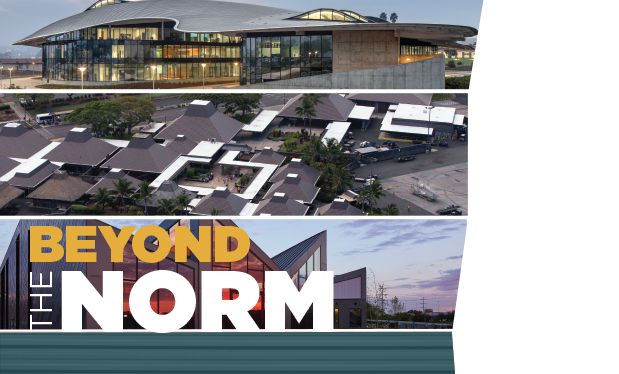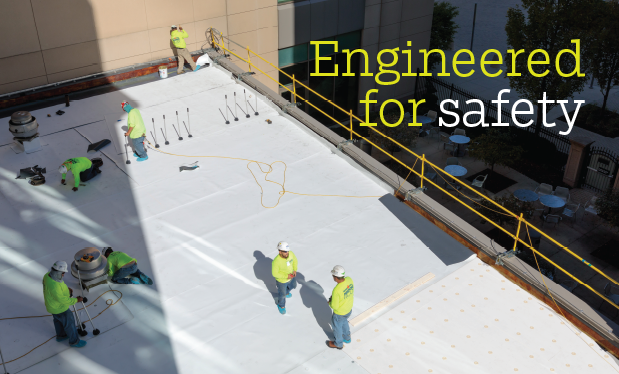As a forensic architect specializing in roofing projects, I find it fascinating how different reroofing can be from original roof system installation. Although there probably are hundreds of angles that could be explored, an especially challenging subset is the reroofing of tall and high-rise buildings, specifically low-slope roof systems in dense urban locations.
Although many of the issues I will discuss apply to the reroofing of all buildings, buildings that are 10 stories or higher present additional challenges simply because of the distance between the ground and where the work takes place and the environment becomes harsher the higher up you go. Why are such projects more difficult, and what could be done during the design and construction of new buildings that would make reroofing these structures less burdensome?
Code-related challenges
Tall and high-rise buildings, like all buildings, are subject to applicable building codes. The most commonly adopted model codes in the U.S. are the International Codes produced by the International Code Council.® The current versions of the I-Codes are the 2018 editions of the International Building Code® and International Energy Conservation Code,® which contain the most relevant roofing-related provisions.

In a best case scenario, roofing-related code requirements are an important consideration in building design; however, architects contend with an almost endless list of considerations when designing new buildings and, generally, the roof is not at the top of the list. Although this is not surprising, there are a few reroofing-related code provisions we should examine as they have a particular relevance to high-rise roofing and can have serious effects during the service lives of buildings if not properly considered.
Perhaps most important in the design of roof assemblies is wind-uplift resistance. Within IBC Chapters 15 and 16 are requirements for wind pressures that must be determined for the field, perimeters and corners of roof areas. This is especially important for tall and high-rise roof system design because the higher the roof, the more severe wind-uplift pressure will be if all other factors are equal (see “Wind-uplift code requirements” below).
In my experience, roof system wind-uplift resistance is not always determined during the design process, which results in roof systems being installed with less than ideal wind-pressure resistances and sometimes less than building code provisions dictate. The ramifications of underdesigned roof systems go beyond a higher likelihood of roof system failure. When such roof systems are eventually replaced, the error may be repeated by simply copying the original roof system, or, conversely, building owners may face higher reroofing project costs as substrates may need to be strengthened to achieve the required attachments.
A relatively simple way to verify designed roof systems have adequate wind-uplift resistance is to engage with roof system manufacturers during the design process. Many roof system manufacturers have technical support staff who can provide designs that have been tested to demonstrate code compliance for wind-uplift resistance based on roof system components, attachment type and method.
Requiring contractors to submit a letter from roof system manufacturers indicating installed systems have been tested and comply with required wind-uplift pressures also can be an effective strategy. Such engagement makes it more likely system deficiencies will be identified and addressed before installation.
An important part of any approach is for roof system designers to determine required design wind-uplift pressures during the design phase so minimum uplift-resistance pressures are known for field, perimeter and corner zones of roof areas. That data can be compared with data from manufacturers to ensure original roof system designs have enough wind-uplift resistance to meet or exceed the calculated design pressures and that reroofing designs meet current code requirements.
Another area that can present challenges is energy conservation. IECC applies to most U.S. jurisdictions and contains many roofing-related provisions, including a minimum-required R-value for roof system insulation. Most tall and high-rise buildings have low-slope roof systems with insulation above the structural roof deck.
For reroofing projects, it is common to discover buildings with existing roof systems where the thickness of existing insulation results in an R-value substantially less than current code requirements. This is a result of the rapid expansion in stringency of minimum-required thermal resistance of low-slope roof systems.
Buildings designed before the 2003 standard were required to have less thermal resistance (and as a result less insulation thickness) compared with buildings designed nine years later when thermal-resistance requirements became substantially higher.
Although minimum required R-values for roof systems remained generally unchanged in the 2015 and 2018 editions of IECC, many buildings currently being reroofed were originally designed with thinner above-deck insulation. This is especially relevant for high-rise reroofing projects because high-rises often have building elements such as rooftop equipment pads; equipment screen supports; dunnage frames; structural, through-wall flashings; roof edge structure; parapet-mounted counterflashings; rooftop safety anchors; window-washing equipment supports; penthouse access points; overflow drainage scuppers; roof drains, etc., that were installed based on the thickness of the original roof system.
Building owners often find raising these adjacent elements to accommodate thicker above-deck insulation or adding additional drainage points to reduce the overall thickness of tapered insulation systems to be prohibitively expensive. In my experience, most building departments will allow less insulation than would be required for a new building when such technical infeasibilities are encountered as long as existing thermal resistance is maintained.
The important point for roof system designers to realize is how much space is needed to accommodate above-deck insulation, including additional space if tapered insulation is used to provide slope for drainage, and to ensure such space is provided. When planning for roof system replacement when space is limited, designers should engage with building code officials early in the process to determine the requirements of particular jurisdictions and negotiate a reasonable way forward before the construction phase to ensure insulation thicknesses are properly represented in bidding documents.
Design-related challenges
It is important to note truly successful roof system designs not only meet or exceed code requirements, but they also provide excellent long-term value for building owners. To do this, forethought must be given to how roof systems will be replaced.
During assessment of existing high-rise roof systems, it is not uncommon to discover roof system terminations obscured by other building elements such as membrane flashings that terminate behind wall panels, behind rooftop equipment screens, or under window or curtain wall systems. Such terminations are challenging because to replace the original roof system in kind necessitates removing a portion of the adjacent system.
For example, a membrane roof flashing that terminates behind a penthouse wall panel would require removing the wall panel to fully remove the existing membrane flashing and install its replacement. This may require a roofing contractor to coordinate with subcontractors for panel removal and replacement to ensure the building remains watertight and work progress is not interrupted.
Often, building owners find the cost of such removal and coordination to be prohibitive; therefore, existing membrane flashings are cut and installed below original flashing height to avoid the need to remove adjacent systems. Although such installations are common, they have drawbacks, which can include new flashing terminations not being as high above the field of the roof compared with the original roof system and, as a result, are more susceptible to water infiltration because of wind-driven rain, drifting snow, etc. Also, flashing heights may fall below the roof system manufacturer’s minimum flashing height requirements, requiring more expensive and time-consuming solutions to comply with manufacturer requirements.
Another common design-related challenge often observed is the transitions between roof system substrates. Construction documents for new buildings often show how common conditions are constructed but often are silent where different conditions abut. Problems with installed roof systems at such transitions are not uncommon, especially where multiple systems come together, such as a penthouse wall intersecting a parapet wall with a railing attachment. This sort of intersection may result in roof systems having to jog in and out to accommodate different substrates and perhaps the use of sealant as the only means of watertightness to handle poorly thought out surface conditions.
Diligent contractors address atypical conditions with in-the-field fixes such as the use of reinforced liquid flashings, custom sheet metal counterflashings and field-modified tapered insulation, but many of these challenges could be avoided with a stronger focus on roof system design during the original design of buildings to ensure substrates are generally uniform and can accommodate required flashing heights in areas where roof systems terminate.
If possible, terminations should not be covered by other building elements that will be problematic and costly to remove and replace during roof system replacement. More robust roof systems should be used beneath paver systems, vegetative elements and photovoltaic systems because repairs to covered roof membranes are more difficult and costly for building owners.
In addition to coordinating with manufacturers’ technical representatives, roof system designers should be in-line with best practices noted in roofing industry guidance documents such as The NRCA Roofing Manual to result in roof systems with the best chance to provide the anticipated service lives.

Because of the fast pace in which buildings are designed and constructed, the level of detail needed for successful building envelope design and implementation often is not achieved. This is especially true for tall and high-rise buildings as these projects are typically the most complex and require many subcontractors to work as a coordinated team to install and properly integrate many wall and roof system components into a cohesive enclosure system.
To improve building enclosure design and performance, the practice of building enclosure commissioning (known as BECx or BEC) is implemented by some building design teams. BEC programs generally are based on ASTM E2813, “Standard Practice for Building Enclosure Commissioning.” Sometimes, a less comprehensive approach called building enclosure peer review is used.
Whatever method is used, the idea is for an independent review of building enclosure elements that are part of the construction documents is conducted with the purpose of ensuring the constructed building enclosure meets or exceeds the owner’s project requirements. During design of a building, a building enclosure agent (typically a design professional with extensive experience in the particular roof and/or wall system being considered) meets with the design team to review building enclosure concepts, offer suggestions for improvement and properly integrate adjacent enclosure systems (such as where the roof system meets the wall system).
These agents also often review and comment when progress construction document sets are issued. During construction, the agents may participate with the testing of enclosure system mockups and/or make site inspections independently or in concert with the building design team and enclosure-related subcontractors. In addition, they may evaluate and offer comment regarding contractor construction submittals and shop drawings.
BEC efforts are most successful when agent involvement begins early in the design stage and is allowed to continue throughout the design and construction of projects.
Building use and access
An underappreciated aspect by building designers and owners of tall and high-rise roof system replacement is the degree to which a building drives the complexity and cost of projects. On a square foot basis, high-rise roof systems can cost more than two or three times as much as the same system installed on low-rise roof areas. Also, roof systems on buildings located in a dense urban core generally are far more costly than more suburban buildings. There are many factors that drive these relative cost increases.
Tall and high-rise building roofs generally have a relatively small area compared with the overall size of the building, and often rooftop space is used for a variety of purposes, including HVAC equipment, communication equipment, dunnage frames, skylights, penthouse spaces, ductwork, signage, walking surfaces for observation or recreation spaces, overburden such as vegetative elements, structural elements for rails, equipment screens, and anchorage points and equipment for window washing and other vertical access activities. These elements present significant challenges during reroofing operations as they often must be removed for roofing areas to be replaced. Even when contractors can work around such elements, progress often is greatly reduced and, as a result, the cost increases.
Building layouts also can result in additional costs. Access to and from roof surfaces or to multiple rooftop areas and levels is a primary consideration. It is not uncommon for the top stop of freight elevators to be below rooftop level, which sometimes requires substantial ingress and egress paths to deliver materials and to remove tear-off and overburden from rooftop areas. Use of such paths also requires contractors to provide surface protection during projects, especially if transport through public or secure spaces is necessary.
For shorter high-rise buildings with existing staging areas at ground level, movement of material using external means via lifts, hoists or cranes may be a more cost-effective option.
Taller buildings, buildings on tight sites or buildings with sensitive uses such as health care may not be good candidates for external equipment access requiring movement of materials within the building. Dumpster placement also can require substantial planning and ingenuity. Dumpster placement must allow for ease of change-out, which can require multiple pick-ups during the day for projects with substantial tear-off, especially heavy tear-off elements such as pavers or when site restrictions limit dumpster size. Some buildings have loading dock areas with limited space and little storage space outside of dumpsters (requiring more extensive coordination of debris removal, material delivery and dumpster delivery).
Building location also can affect cost. Buildings in dense downtown areas generally are subject to more restrictions and permitting requirements. Mobilization, debris removal, material delivery, and the time and effort for workers to access the building also can be more difficult and costly. Some downtown areas have special zones where construction may be limited during certain times of year such as during the holidays or for special events. Roof system designers and contractors should investigate these potential limits for buildings in dense urban areas to ensure effective cost estimating and project management for projects.
Tall and high-rise building owners and managers often have restrictions regarding the methods used during construction and the systems installed within or on buildings. Roof system designers and roofing contractors should explore the construction culture of the buildings where roofing work is planned before design or bid submittal as building-specific requirements can limit roof system choices, installation methods and general operations during construction.
Some owners require roof systems:
- Meet above-code level requirements (fire classification or wind-uplift resistance, for example)
- Satisfy voluntary program requirements such as LEED® or Green Globes
- Include common sustainability features such as a reflective surface or vegetative elements
- Meet insurance carrier requirements
- Limit or be free of certain chemicals
- Restrict or impose moratoriums on hot work
- Limit work hours or use of elevators and loading docks to certain days or time of day
- Are installed by workers with particular roofing industry safety, technical and/or security certifications
- Be installed by companies that are members of local, state or national trade associations
- Comply with special building, organizational or governmental provisions
Being unaware of these restrictions can result in the need for redesign, cost estimates that are too low and underbidding of projects.
Final thoughts
Roof system replacements for tall and high-rise buildings face unique challenges, many of which are driven by the original building design. In my experience, I see growing awareness of these issues among building designers, and there seems to be an increase in the use of BEC and peer review related to building envelope design. However, many projects have substantial deficits in roof system design leaving buildings susceptible to issues with water infiltration, roof system failure and systems not reaching their expected service lives.
Projects with a deliberative focus on roof system design, constructability and replaceability by experienced building enclosure designers tend to be successful, especially when purposeful quality control and assurance measures are used during construction to ensure designs are installed as intended.
Jason Wilen, AIA, CDT, RRO, is a senior associate with Klein & Hoffman, Chicago.
For more about this topic, consider attending “Reroofing in the Sky: Special Considerations for High-rise Roof Replacement,” a panel that will take place Feb. 5, 2020, at the International Roofing Expo® in Dallas. Panelists will include roofing contractors experienced in reroofing tall and high-rise buildings. To learn more, go to www.theroofingexpo.com.
For articles related to this topic, see:
“Keeping an Eye on I-Codes,”
December 2017 and January 2018 issues
“Keeping Up with I-Codes,”
March 2015 issue
Wind-uplift code requirements
Roof system designers should determine design wind loads and design roof systems to resist determined wind-uplift pressures. And roof system manufacturers should be testing their roof systems per FM 4474, “Evaluating the Simulated Wind Uplift Resistance of Roof Assemblies Using Static Positive and/or Negative Differential Pressures”; UL 580, “Standard for Safety Tests for Uplift Resistance of Roof Assemblies”; or UL 1897, “Standard for Safety Uplift Tests for Roof Covering Systems” (as required in Section 1504.3.1 of the International Building Code,® 2018 edition) and making wind-uplift pressure resistance data available to roof system designers.
Prefabricated roof edge metal manufacturers should make ES-1 data available, as well. In my experience, roof system and edge metal manufacturers generally have wind-uplift pressure data available, but roof system designers have to calculate the design wind pressures and ensure their designs are code-compliant by asking manufacturers for wind-uplift data, an exercise that is often omitted from the design process.
Wind-uplift resistance is especially important for roof systems installed on high-rise buildings because the taller the roof surface, the higher the uplift pressure per ASCE 7, “Minimum Design Loads and Associated Criteria for Buildings and Other Structures.”
For example, per ASCE 7-16, an apartment building in Chicago not near Lake Michigan would have a design uplift pressure (depending on assumptions) of about 62 pounds per square foot at the corner of a roof 30 feet above the ground. The same roof system on a roof surface 200 feet above the ground would be almost 130 psf, more than double the design uplift pressure of the lower roof.



